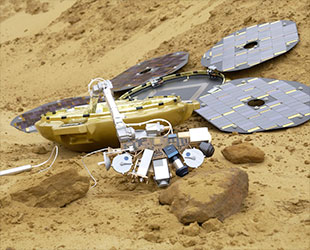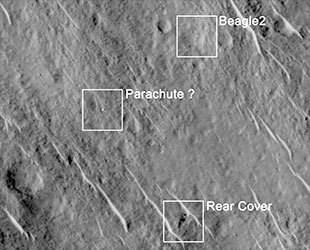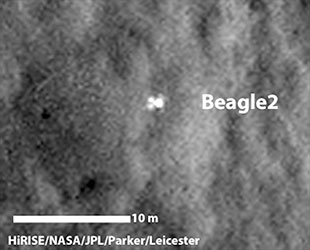January 16, 2015 – The United Kingdom's Beagle 2 Mars lander, lost on the Red Planet since 2003, has been found partially deployed on the surface by a NASA orbiter.
Images captured by the HiRISE camera on NASA's Mars Reconnaissance Orbiter (MRO) reveal clear evidence for the lander and convincing indications for its key entry and descent components on Mars' surface within the expected landing area of Isidis Planitia, an impact basin close to the equator. The observations show that Beagle 2 survived its Dec. 25, 2003 touchdown long enough to at least partially deploy its solar arrays.
Beagle 2 hitched a ride to the Red Planet on the European Space Agency's Mars Express mission. The lander, which was the product of a collaboration between UK academic groups and industrial companies, was designed to search for signs of past or present microbiological life on Mars.
"I am delighted that Beagle 2 has finally been found," said University of Leicester professor Mark Sims, who led the lander's initial study phase and was the Beagle 2 mission manager. "Every Christmas Day since 2003 I've wondered what happened to Beagle 2."
"To be frank, I had all but given up hope of ever knowing what happened," Sims added. "The images show that we came so close to achieving the goal of science on Mars."

Model of Beagle 2 deployed in data gathering mode. (Beagle 2) |
HiRISE images first searched by Michael Croon, a former member of ESA's Mars Express operations team, offered the evidence for locating Beagle 2, including what may be its rear cover with pilot/drogue chute still attached and its main parachute near by. Due to the small size of Beagle 2, less than 7 feet (2 meters) across for the fully deployed lander, it was right at the limit of detection for the cameras orbiting Mars.
"We've been looking for all the past landers with HiRISE, this is the first time we found one that didn't send a signal after it landed," said Alfred McEwen, principal investigator of the HiRISE mission and a professor in the University of Arizona Lunar and Planetary Lab in Tucson. "If the landing sequence works correctly, the probe sends a radio signal, and you can use that to pinpoint where it is coming from, even if it broadcasts only very briefly. But in the case of Beagle 2, we didn't get anything. All we had to go by was the target landing area."
The planned landing area for Beagle 2 was approximately 105 by 62 miles (170 by 100 km) within Isidis Planitia. The lander's initial detection came from HiRISE images taken in February 2013 and June 2014. Croon had submitted a request through the public program HiWish, which allows anyone to submit suggestions for HiRISE imaging targets.

Annotated image showing where features seen in an observation by NASA's Mars Reconnaissance Orbiter have been identified as hardware from the 2003 arrival on Mars of the United Kingdom's Beagle 2 lander. (Leicester/Beagle 2/NASA/UA) |
"He found something that would be a good candidate at the edge of the frame," McEwen described. "But contrast was low in the first image, and it was difficult to convince yourself something special was there."
The team acquired several more images, which showed a bright spot that seemed to move around.
"That was consistent with Beagle 2," McEwen explained. "Because its solar panels were arranged in petals, each one would reflect light differently depending on the angles of the sun and MRO, especially if the lander was resting on sloping ground."
The data further suggested only a partial deployment of Beagle 2 following its landing, which would explain why no signal was received from the lander. Full deployment of all of its solar panels was needed to expose the RF antenna, which would transmit data and receive commands from Earth via orbiting Mars spacecraft.

Configuration interpreted as the UK's Beagle 2 lander, with solar panels at least partially deployed. (HiRISE/NASA/Parker/Leicester) |
The images reveal only two or three of the motorized solar panels, but that may be due to their favorable tilts for sun glints. Further imaging and analysis is planned to narrow down the options for what happened.
"I can imagine the sense of closure that the Beagle team must feel," said Richard Zurek, now MRO project scientist and previously for NASA's still-missing 1998 Mars Polar Lander. "MRO has helped find safe landing sites on Mars for the Curiosity and Phoenix missions and has searched for missing craft to learn what may have gone wrong."
The discovery of the Beagle 2 benefited from an additional image clean-up the HiRISE team has been testing, which removes very subtle electronic noise patterns that have to do with the way the instruments work on MRO.
"It's an extremely difficult task, as the craft are small and the search areas are vast," Zurek concluded. "It takes the best camera we have in Mars orbit and work by dedicated individuals to be successful at this."
